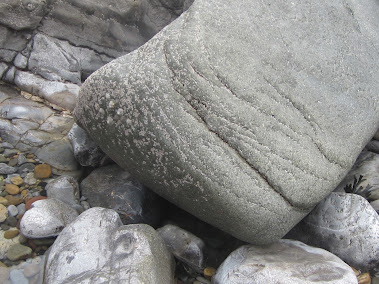At the eastern end of the Ogof Golchfa site (SM 742 236) there is a perfect example of a micro-tonalite sill, sitting conformably in a sequence of thin-bedded sandstones and shales belonging to the Cambrian Solva Beds. The sill itself is assumed to be of Ordovician age, intruded along a bedding plane, joint or fracture. It's a bit more complicated than that, because it varies in thickness between 5m and c 20m, and there are one or two offshoots which don't appear on the geological map at all. These are difficult to spot because the sill and the argillaceous rocks have virtually the same colour -- a distinctive greenish-grey.
Reading the features is made more difficult because the sedimentary beds are metamorphosed or baked close to the sill edges, so that they look more like slate. And in the sill itself, the geologists noted that the feldspar crystals are small close to the margins and larger in the middle as a consequence of differential cooling or solidification rates.
On those parts of the sill close to sea level, where marine processes operate, there are good fresh exposures of the rock surface. The greenish colour is everywhere apparent, and there are many fractures with bands of quartz and other secondary minerals.
Fine grained micro-tonalite close to the edge of the sill
Turning to the Limeslade boulder, the colour similarity is striking. It has a greenish hue, unlike the Preseli dolerites which are predominantly blue or grey in colour. Is this down to a different copper (Cu) content? We know from recent work that the Limeslade boulder has a considerably higher copper content than most of the Preseli dolerites; the results will be published in due course. On the other hand a green colouration can also come from minerals containing iron, chromium or manganese, and other minerals can also be involved.
Visually, this photo taken on my visit to Ogof Golchfa yesterday reminds me of the Limeslade boulder.
Close up of a rock face at Ogof Golchfa where the feldspar crystals are of moderate size.
The Limeslade boulder, with a surface heavily abraded by shoreline processes.
According to Wikipedia, tonalite is an igneous, plutonic (intrusive) rock, of felsic composition, with phaneritic (coarse-grained) texture. Feldspar is present as plagioclase (typically oligoclase or andesine) with alkali feldspar making up less than 10% of the total feldspar content. Quartz (SiO2) is present as more than 20% of the total quartz-alkali feldspar-plagioclase-feldspathoid (QAPF) content of the rock. Amphiboles and biotite are common accessory minerals. In older references tonalite is sometimes used as a synonym for quartz diorite.
I don't want to be carried away here, and I am not quite convinced that the rock at Ogof Golchfa is the same as that of the Limeslade boulder. But there are other similar sills with a greenish colour in the St Davids area and along the North Pembrokeshire coast, and one obvious provenancing candidate is Carn Ysgubor on Ramsey Island, just a few km away, referred to by BGS as having a large micro-tonalite intrusion of approximately the same age as that of Ogof Golchfa. As they say, watch this space........







No comments:
Post a Comment
Please leave your message here